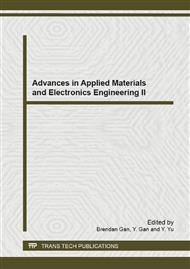[1]
K. L. Chopra, S. Major and D. K. Pandya: Thin Solid Films Vol. 102 (1983) p.1.
Google Scholar
[2]
I. Hamberg and C. G. Granqvist: J. Appl. Phys. Vol. 60 (1986) p. R123.
Google Scholar
[3]
C. G. Granqvist: Appl. Phys. A Vol. 57 (1993) p.19.
Google Scholar
[4]
M. Bender, W. Seelig, C. Daube, H. Frankenberger, B. Ocker and J. Stollenwerk: Thin Solid Films Vol. 326 (1998) p.72.
DOI: 10.1016/s0040-6090(98)00521-5
Google Scholar
[5]
Y. Shigesato, D. C. Paine and T. E. Hayens: Jpn. J. Appl. Phys. Vol. 32 (1993) p. L1352.
Google Scholar
[6]
J. F. Smith, A. J. Aronson, D. Chen and W. H. Class: Thin Solid Films Vol. 72 (1980) p.469.
Google Scholar
[7]
J. C. Manifacier, L. Szepessy, J. F. Bress and M. Perotin: Mater. Res. Bull Vol. 14 (1979) p.163.
Google Scholar
[8]
R. B. H. Tahar, T. Ban, Y. Ohya and Y. Takahashi: J. Appl. Phys Vol. 83 (1998) p.2139.
Google Scholar
[9]
C. H. Han , S. D. Han, J. Gwak and S. P. Khatkar: Mater. Lett. Vol. 61 (2007) p.1701.
Google Scholar
[10]
K. K. Li, G. H. Haertling and W. Y. Howng: Integr. Ferroelectr. Vol. 3 (1993) p.81.
Google Scholar
[11]
S. C. Chang: Microelectron, J. Vol. 38 (2007) p.1220.
Google Scholar
[12]
M. J. Alam and D. C. Cameron, Thin Solid Films Vol. 420-421 (2002) p.76.
Google Scholar
[13]
B. L. Zhu, X. H. Sun and S. Guo: J. J. Appl. Phys. Vol. 45 (2006) p.7860.
Google Scholar
[14]
Z. H. Li, Y. P. Ke and D. Y. Ren: Trans. Nonferrous. Met. Soc. China. Vol. 18 (2008) p.366.
Google Scholar
[15]
E. Çetinörgü, S. Goldsmith and R.L. Boxman: Surf. Coat. Technol. Vol. 201 (2007) p.7266.
Google Scholar
[16]
J. A. Thornton: Annu. Rev. Mater. Sci. Vol. 7 (1977) p.239.
Google Scholar
[17]
Y. Hu, X. Diao, C. Wang, W. Hao and T. Wang: Vacuum Vol. 75 (2004) p.183.
Google Scholar
[18]
M. Bender, W. Seelig, C. Daube, H. Frankenberger, B. Ocker and J. Stollenwerk: Thin Solid Films Vol. 326 (1998) p.72.
DOI: 10.1016/s0040-6090(98)00521-5
Google Scholar
[19]
K. L. Chopra, S. Major and D. R. Panya: Thin Solid Films Vol. 102 (1983) p.1.
Google Scholar
[20]
R. Ota, S. Seki, M. Ogawa, T. Nishide, A. Shida, M. Ide and Y. Sawada: Thin Solid Films Vol. 411 (2002) p.42.
DOI: 10.1016/s0040-6090(02)00171-2
Google Scholar
[21]
S. Seki, Y. Sawada, M. Ogawa, M. Yamamoto, Y. Kagota, A. Shida and M. Ide: Surf. Coat. Technol. Vol. 169-170 (2003) p.525.
Google Scholar
[22]
E. Nishimura and H. Ohkawa: Thin Solid Films Vol. 445 (2003) p.235.
Google Scholar
[23]
A. Solieman and M. A. Aegerter: Thin Solid Films Vol. 502 (2006) p.205.
Google Scholar
[24]
Z. H. Li, Y. P. Ke and D. Y. Ren: Trans. Nonferrous. Met. Soc. China. Vol. 18 (2008) p.366.
Google Scholar
[25]
E. Celik, U. Aybarc, M. F. Ebeoglugil, I. Birlik and O. Culha: J. Sol-Gel Sci. Technol. Vol. 50 (2009) p.337.
DOI: 10.1007/s10971-009-1931-4
Google Scholar
[26]
T. S. Renugadevi and S. Gayathri: Int. J. Pharm. Sci. Rev. Res. Vol. 2 (2010) p.106.
Google Scholar
[27]
Z. H. Li, Y. P. Ke and D. Y. Ren, Trans: Nonferrous. Met. Soc. China. Vol. 18 (2008) p.366.
Google Scholar


